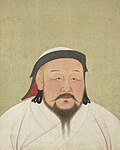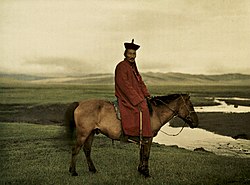Mongols
- REDIRECT Template:See also
The name Mongols (Mongolian: Монгол Mongol) explains one or more ethnic groups. A narrow definition includes the Mongols proper (self-designation Monggol), which can be split into eastern and western Mongols. In a broader sense, the Mongol peoples also people who speak a Mongolic language but use other self-designations, such as the Kalmyks of eastern Europe.
 Genghis Khan | |
| Total population | |
|---|---|
| 12 million | |
| Regions with significant populations | |
| Mongolia, China, Russia | |
| Languages | |
| Mongolic languages | |
| Religion | |
| Predominantly Tibetan Buddhism and Shamanism with minorities of Christianity, Islam, Atheism | |
| Related ethnic groups | |
| Khalkha, Daurs, Buryats, Evenks, Dorbots, Kalmyks, Oirats, Chakhars, Tumeds, Ordoses, Bayad, Dariganga, Urianhai, Uzemchin and Zakhchin. |
The name Monggol has its meaning in the Tungusic languages and usually means "the invincible ones". At first, it was applied to a small and stillinsignificant tribe in the area of the Onon River. In the 13th, century it grew into an umbrella term for a large group of tribes united under the rule of Genghis Khan.
Religion
The polytheistic (believing in many gods) Mongols thought that good and evil spirits controlled the world. They also believed in a sky god, who ruled all the spirits. They called him "Tengri" (TENG gree), which means "the great god of heaven".[1] The Mongols lived in fear of the spirits and hoped for blessings from them.
Every yurt had small idols made of felt.[1] The wives and daughters of the nobles made those idols at sewing parties.[1] The Mongols believed that the idols protected their families and animals. Before every meal, they put food and drink on the idols' lips. They also prayed to them.[1]
The Mongols believed that some men, called "shamans" (SHAH muns), had power over the spirits. The shamans were the priests of the traditional Mongol religion, called "shamanism" (SHAH muh NIZ um).[1] The shamans were medicine men and witch doctors and used a special language when doing their magical rituals.[1] The Mongols talked to their shamans they made major big decisions and followed their advice.[1]
Other religions
The later empire of the Mongols had many people with many religions, including Christians.[1] The most important Christian group in the Mongol Empire was the Nestorian Church, also called the Assyrian Church of the East. These Christians were named for Nestorius, bishop of Constantinople.[1]
United States
Mongols Media
Asia in 330–555, showing the Rouran Khaganate and its neighbors, including the Tuoba Wei and the Tuyuhun, all of which were established by Proto-Mongols
Yuan dynasty Mongol rider
Analysis of DNA extracted from the remains of Avars found in Hungary has provided evidence that they originated in what is now Mongolia.
A portrait of Kublai Khan by Araniko (1245–1306)
Mongol huntsmen, Ming dynasty
The Northern Yuan dynasty and Turco-Mongol residual states and domains by the 15th century
Map showing wars between Qing dynasty and Dzungar Khanate
A Dzungar soldier called Ayusi from the high Qing era, by Giuseppe Castiglione, 1755
The Battle of Oroi-Jalatu in 1755 between the Qing (that ruled China at the time) and Mongol Dzungar armies. The fall of the Dzungar Khanate
A Mongolian Buddhist noble in Urga, 1913









